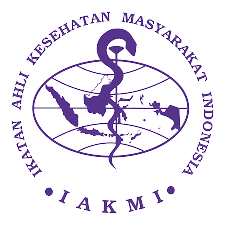FACTORS ASSOCIATED TO EARLY INTRODUCTION OF COMPLEMENTARY FEEDING : META ANALYSIS STUDY IN INDONESIA
Abstract
Keywords
Full Text:
PDFReferences
Okafor CB. et al. Exclusive Breastfeeding Knowledge, Intention to Practice and Predictors among Primiparous Women in Enugu South-East, Nigeria. HindawiJournal of Pregnancy. 2019.
WHO. Infant and young child feeding. France: WHO Press; 2009.
WHO. Global Targets 2025. 2015.
Unicef. Infant and young child feeding ;adopting optimal feeding practices is fundamental to a child's survival, growth and development, but too few children benefit 2019 [Available from: https://data.unicef.org/topic/nutrition/infant-and-young-child-feeding/.
Kementerian kesehatan RI. Riset Kesehatan Dasar tahun 2013. Jakarta: Kementerian kesehatan RI; 2013.
Kementerian kesehatan RI. Riset Kesehatan Dasar tahun 2018 Jakarta: Kementerian kesehatan RI; 2018.
Nasional KPPNBPP. LAMPIRAN PERATURAN PRESIDEN REPUBLIK INDONESIA NOMOR 2 TAHUN 2015 TENTANG RENCANA PEMBANGUNAN JANGKA MENENGAH NASIONAL (RPJMN) 2015-2019. 2014.
Santi MY. Upaya Peningkatan Cakupan Asi Eksklusif dan Inisiasi Menyusu Dini (IMD). Jurnal Kesmas Indonesia. 2017;9(1):83.
Sulistiani T. Hubungan Pemberian Makanan Pendamping ASI (MP-ASI) Dini Dengan Status Gizi Dan Kejadian Diare Pada Bayi Usia 0-6 Bulan Di Posyandu Balita Wilayah Kelurahan Banjarejo Kota Madiun Madiun. Stikes Bhakti Husada Mulia Madiun. 2018.
Tang L, Lee AH, Binns CW. Predictors of early introduction of complementary feeding: Longitudinal study. Pediatrics International. 2015;57(1).
Basri H, Hadju V. reastfeeding and complementary food on nutritional status infants in Indonesia. Enferm Clin. 2019;30.
Masuke R, Msuya SE, Mahande JM, Diarz EJ, Stray-Pedersen B, Jahanpour O, et al. Effect of inappropriate complementary feeding practices on the nutritional status of children aged 6-24 months in urban Moshi, Northern Tanzania: Cohort study. PLoS One. 2021;16(5).
Zielinska MA, et al. Factors Influencing the Age of Complementary Feeding"”A Cross-Sectional Study from Two European Countries. Int J Environ Res Public Health. 2019;16(20).
Semahegn A, Tesfaye G, Bogale A. Complementary feeding practice of mothers and associated factors in Hiwot Fana Specialized Hospital, Eastern Ethiopia. Pan African Medical Journal. 2014;18(143).
Kostecka M, Jackowska I, Kostecka J. Factors Affecting Complementary Feeding of Infants. A Pilot Study Conducted after the Introduction of New Infant Feeding Guidelines in Poland. Nutrients.13(1).
Wang L, Grieken Av, Velde LAvd, Vlasblom E, Beltman M, L'Hoir MP, et al. Factors associated with early introduction of complementary feeding and consumption of non-recommended foods among Dutch infants: the BeeBOFT study. BMC Public Health. 2019;19(388).
Nkoka O, Mhone TG, Ntenda PAM. Factors associated with complementary feeding practices among children aged 6-23 mo in Malawi: an analysis of the Demographic and Health Survey 2015-2016. International Health. 2018;10(6).
Republik Indonesia MK. Peraturan Menteri Kesehatan Republik Indonesia Nomor 21 Tahun 2020 Tentang Rencana Strategis Kementerian Kesehatan Tahun 2020-2024 Jakarta Kemenkes. 2020.
DOI: https://doi.org/10.37905/ijhsmr.v2i2.19143
Refbacks
- There are currently no refbacks.









